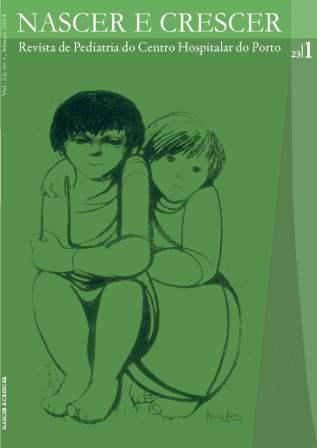Caso dermatológico
DOI:
https://doi.org/10.25753/BirthGrowthMJ.v23.i1.8593Palavras-chave:
placa eritematosa anular, tinha do corpo, dermatiteResumo
Criança do sexo feminino, com dois anos de idade, sem antecedentes pessoais e familiares relevantes. Vive com os pais e uma irmã em meio urbano, com boas condições sócio-económicas. Sem animais domésticos. Segunda a mãe, a criança apresentava uma lesão anular ligeiramente pruriginosa localizada na região vulvar, com quatro semanas de evolução. A criança foi inicialmente observada em Pediatria sendo medicada para uma dermatite irritativa das fraldas. Por aumento progressivo da lesão a criança foi referenciada à consulta de dermatologia (Figura 1). Ao exame objetivo observava -se uma placa eritematosa, policíclica com centro claro e bordo elevado ocupando toda a área vulvar. O restante exame objetivo era normal.Downloads
Referências
Jordan WE, Lawson KD, Berg RW, Franxman JJ, Marrer AM. Diaper dermatitis: frequency and severity among a general infant population. Pediatr Dermatol 1986; 3:198 -207.
Grant WW, Street L, Fearnow RG. Diaper rashes in infancy. Clin Pediatr 1973; 12:714 -6.
Berg RW, Buckingham KW, Stewart RL. Etiologic factors in diaper dermatitis: the role of urine. Pediatr Dermatol 1986; 3:102 -6.
Noble WC. Microbiology of human skin. In: Rook A, ed. Major problems in dermatology. 2nd ed. London: Lloyd - Luke Medical Books, 1981; 2:330 -1.
Leyden JJ. Diaper dermatitis. Dermatol Clin 1986; 4:29 -8.
Seebacher C, Bouchara JP, Mignon B. Updates on the epidemiology of dermatophyte infections. Mycopathologia 2008; 166:335 -52.
Bonifaz A, Saúl A. Comparative study between terbinafine 1% emulsion -gel versus ketoconazole 2% cream in tinea cruris and tinea corporis. Eur J Dermatol 2000; 10:107 -9.
Downloads
Publicado
Como Citar
Edição
Secção
Licença
Copyright e Direitos dos Autores
Todos os artigos publicados na Revista Nascer e Crescer – Birth and Growth Medical Journal são de acesso aberto e cumprem os requisitos das agências de financiamento ou instituições académicas. Relativamente à utilização por terceiros a Nascer e Crescer – Birth and Growth Medical Journal rege-se pelos termos da licença Creative Commons "Atribuição - Uso Não-Comercial - (CC-BY-NC)"".
É da responsabilidade do autor obter permissão para reproduzir figuras, tabelas, etc. de outras publicações.
Juntamente com a submissão do artigo, os autores devem enviar a Declaração de conflito de interesses e formulário de autoria. Será enviado um e-mail ao autor correspondente, confirmando a receção do manuscrito.
Os autores ficam autorizados a disponibilizar os seus artigos em repositórios das suas instituições de origem, desde que mencionem sempre onde foram publicados e de acordo com a licença Creative Commons.


